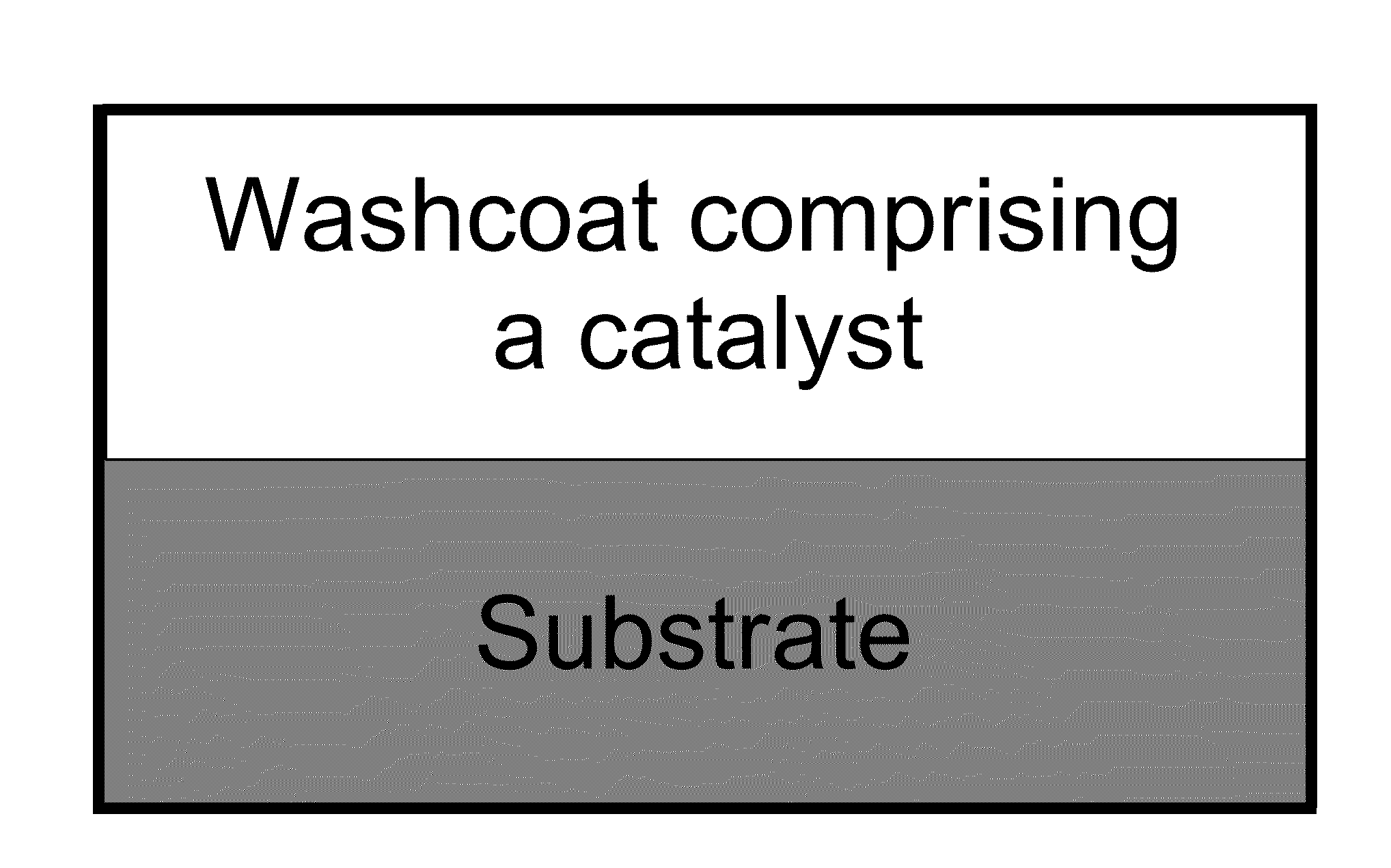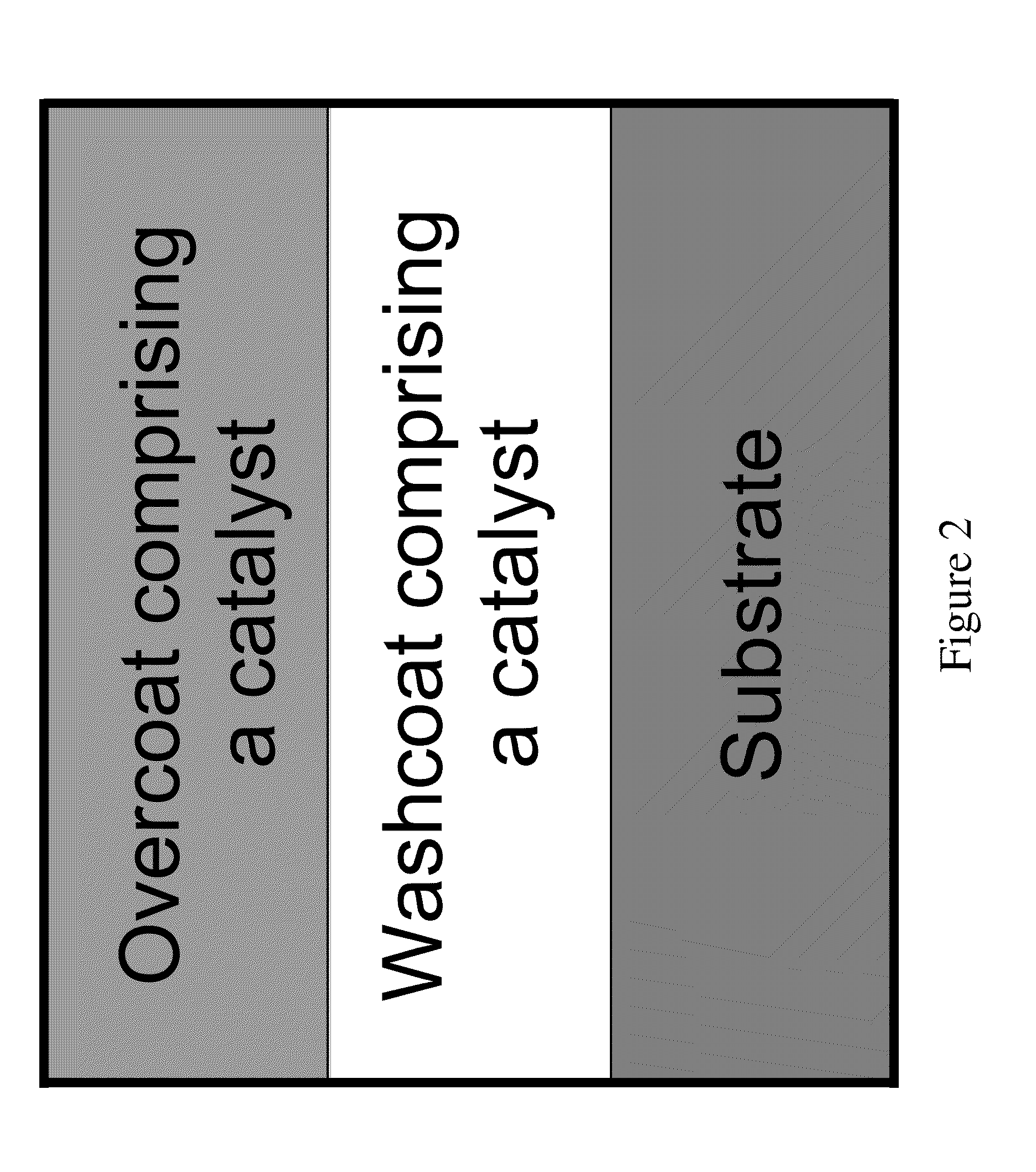Catalyst with Lanthanide-Doped Zirconia and Methods of Making
a technology of lanthanide and catalyst, which is applied in the direction of catalyst activation/preparation, metal/metal-oxide/metal-hydroxide catalyst, etc., can solve the problems of reducing the lifetime of the catalyst system, reducing the amount of pgm catalyst deactivated, and increasing the amount of metallic pgm
- Summary
- Abstract
- Description
- Claims
- Application Information
AI Technical Summary
Benefits of technology
Problems solved by technology
Method used
Image
Examples
example 1
Generation of Washcoats and Overcoats Comprising Traditional Support Oxides
[0174]The following is a representative protocol for the production of washcoats and overcoats comprising traditional support oxides. Such washcoats and overcoats can be used in combination with washcoats and overcoats comprising the Ln-ZrO2-based MMOSOs of the present invention. The protocols in this Example represent standard techniques known in the art (see, for example, U.S. Pat. No. 7,641,875).
[0175]Traditional washcoats were generated as follows. A slurry comprising the OSM, alumina powder and lanthanide nitrate solution (commercially available as lanthanum nitrate product code 5248 from Molycorp, Inc., Mountain Pass, Calif.) in deionized water was generated. The slurry was then milled in a Szegvari Type IS Atrittor until the rheology was suitable for coating the support. A cordierite honeycomb support was dipped into the slurry. Excess slurry was blown from the support with an air jet. The support was ...
example 2
Generation of Overcoats Comprising Doped ZrO2-based MMOSOs
[0177]A 10% Pr—ZrO2-based MMOSO overcoat was generated using the following procedure. This procedure can generally be used to generate overcoats containing Ln-ZrO2-based MMOSOs.
[0178]A 10% Pr—ZrO2-based MMOSO / Ce0.3Zr0.6Nd0.05Y0.05O2 (OSM) (1.5:1 ratio) overcoat slurry containing 38% solid (by weight) was generated as follows. The appropriate amount of 10% Pr—ZrO2, Ce0.3Zr0.6Nd0.05Y0.05O2, and de-ionized water were weighed out in separate containers. The 10% Pr—ZrO2 and Ce0.3Zr0.6Nd0.05Y0.05O2 were weighed out in a 1.5:1 ratio. Acetic acid (0.5% relative to the solids) was weighed and then added to the de-ionized water container. The above reactants were then combined into an attrition-mill as follows: 1) 75-80% of the de-ionized water and acetic acid solution was added; 2) the 10% Pr—ZrO2 and the Ce0.3Zr0.6Nd0.05Y0.05O2 were added; 3) the remaining de-ionized water and acetic acid solution was added. The resulting slurry was ...
example 3
Evaluation of the Effect of Doped ZrO2-Based MMOSOs on NOx Light-Off Temperature
[0181]The performance of the TWC catalyst systems containing Ln-ZrO2-based MMOSOs was evaluated by testing the catalysts on a synthetic gas flow reactor that closely simulates the engine-out gas chemistry and conditions (e.g., temperature) found in vehicles.
[0182]The catalyst systems containing 0.25% Rh (by weight) at a coating of oxide at 125 g / L were tested (see Table 1) on a washcoat comprising an OSM made by either the IWCP or HTP process. A representative procedure for making an OSM by the IWCP process is described in Example 10. A representative procedure for making an OSM by the HTP process is described in Example 11.
TABLE 1Catalyst SystemNOx T50 (oxide used)Process(° C.)a) 10% La—Al2O3HTP284.8b) Nd0.05Pr0.05Ce0.30Zr0.60O2HTP301.8IWCP292.4c) La0.10Zr0.90O2HTP273.8d) Pr0.10Zr0.90O2HTP274.7IWCP262.2
[0183]The catalyst formulations were aged by exposure to slightly rich exhaust for 20 hours at 1000° C...
PUM
| Property | Measurement | Unit |
|---|---|---|
| concentrations | aaaaa | aaaaa |
| concentrations | aaaaa | aaaaa |
| temperature | aaaaa | aaaaa |
Abstract
Description
Claims
Application Information
 Login to View More
Login to View More - R&D
- Intellectual Property
- Life Sciences
- Materials
- Tech Scout
- Unparalleled Data Quality
- Higher Quality Content
- 60% Fewer Hallucinations
Browse by: Latest US Patents, China's latest patents, Technical Efficacy Thesaurus, Application Domain, Technology Topic, Popular Technical Reports.
© 2025 PatSnap. All rights reserved.Legal|Privacy policy|Modern Slavery Act Transparency Statement|Sitemap|About US| Contact US: help@patsnap.com



